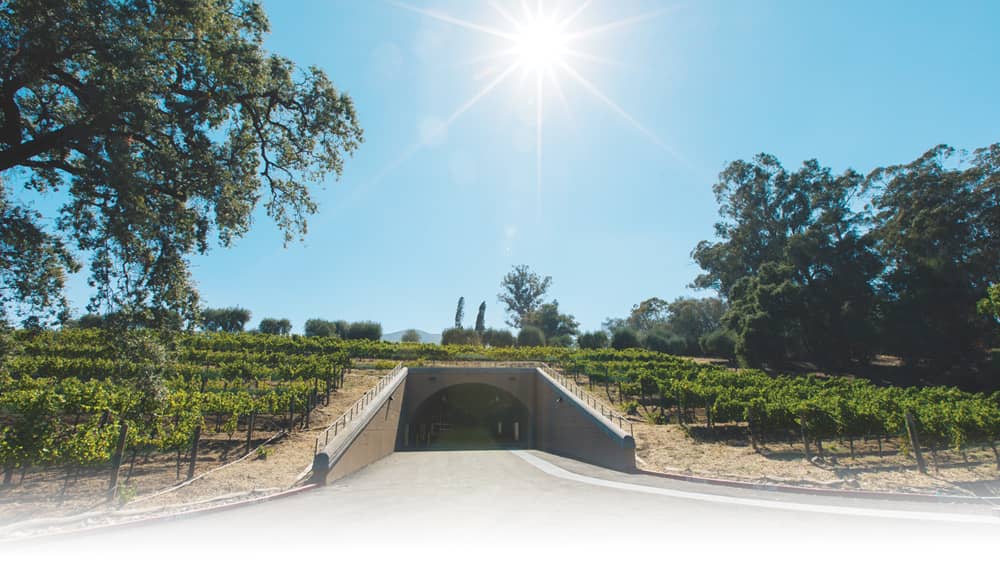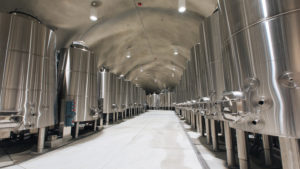
Inglenook unveiled its new 22,000-square-foot winery cave in late August, and the winery was used for the first time for this year’s harvest. “Most wineries design caves for barrel aging and storage, but we are proud that ours stands out as a 22,000-square-foot production cave where our winemaking team can craft Inglenook’s world-renowned, elegant wines,” said Francis Ford Coppola, the proprietor of Inglenook in a statement. “Our new winery cave is so astounding, extensive and spectacular in its visuals, dimensions, and sheer audacity. Together with my family, I am just the third steward of this legendary estate. Since it was founded in Napa Valley in 1879, Inglenook has been recognized around the world for its innovation and industry leadership. This new production cave is another shining achievement in Inglenook’s illustrious 143-year history.”
Taking a cue from winemaking facilities from centuries ago, Inglenook’s new winery is eco-friendly and doesn’t require heating and cooling, as caves naturally maintain cooler temperatures throughout the year. Novel in its approach and tucked beneath a knoll on the south side of the estate, the cave is also safe from the occasional threat of wildfire, and the entire cave is protected by sprinklers.

Each fermentation tank is equipped with a dedicated pump for pump-overs and thermal regulation hardware. Cutting-edge software allows the winemaking team to remotely monitor subtle fluctuations in fermentation dynamics as the grapes ferment in the tanks just after being harvested. For example, the winemaking team will be notified immediately if a fermentation stalls in the middle of the night, and they can remotely and instantly increase the temperature within the tank, ensuring the quality of the wine at a critical time in the winemaking process. Inglenook’s director of winemaking, Philippe Bascaules, favors tanks for red wine fermentation that are somewhat taller and smaller in diameter, which results in a smaller extraction surface relative to the juice volume. This gives Philippe and the winemaking team greater control over extraction, ultimately leading to more elegant, nuanced wines. Raising the bar on quality winemaking even further, Inglenook has a separate temperature-controlled room devoted exclusively to the making of Inglenook’s white wines, which are fermented in barrels and stainless steel drums.
“To have each tank allocated to one specific vineyard block is extraordinary, and this level of customization in our winemaking is an important advantage that enhances our ability to make the world-renowned wines for which Inglenook is known. We now have infinite possibilities, which will lead to even more complex wines,” said Bascaules.
The Inglenook team broke ground on the new winery at the end of 2018. The cave was excavated under a hillside vineyard near the estate’s majestic chateau, which was built in 1887. For structural integrity, a diamond-shaped cave was excavated around a solid, central mass, making it similar to a baseball diamond. The “pitcher’s mound” is the solid central support, surrounded by a diamond-shaped tunnel that extends from “home plate” at the cave’s eastern entrance, north to “first base,” west to “second base,” south to “third base,” and back to home plate, the cave’s portal. The portal’s look was inspired by the design of the entrance to the caves at Château Lafite Rothschild. During harvest, Inglenook’s organically farmed fruit will be carefully sorted by hand in the portal and bottling will occur in that same area later in the year.
The project began with excavation of the cave by Nordby Wine Caves and work progressed with Nordby Construction Company as General Contractor for the project.



